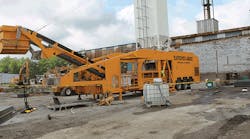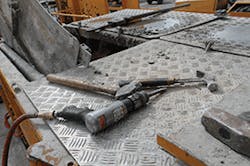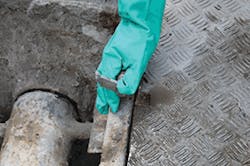It was an overcast, chilly, Saturday morning in May 2014 when a young worker in Kentucky lost his life in an industrial incident. An investigation into his death hopefully will save the lives of workers in the future.
On that morning – May 17, 2014, at 9 a.m. – a 21-year-old foreman and two coworkers were instructed to clean a Rapidmix 400 C industrial continuous mixing plant in preparation for a job the following week. The mixing plant, which had not been used or cleaned for several months, was located in the company's lot next to the maintenance shop.
Once the foreman and two employees had cleared much of the dried, stuck-on concrete from the vein feeder, the foreman started the mixer section to remove the remaining debris, creating a cloud of dust. The foreman instructed the two employees to leave the area so they would not breathe in dust particles. He then stepped onto the mixer's metal doors, intending to exit from the opposite side of the mixer.
The two pairs of doors that covered the opening of the mixer each measured 31½ by 53 inches. Each pair of doors was hinged in the center with two, 2-inch tall hinges. Each door opened and closed on the outer edge of the mixer unit, controlled by one interlock switch for the set of doors on the left and one interlock switch for the set of doors on the right.
As the foreman shifted his weight onto one of the metal doors, the door collapsed into the mixer, along with the victim. By the time one of the employees hit the emergency stop switch, the young foreman was chest high in the 14-foot-long mixing shafts with 6-inch by 8-inch paddles; the shafts rotated at 110 RPM. A 911 call was placed, but the young foreman was pronounced dead at the scene.
Mixer Was in Need of Repair
The Kentucky Fatality Assessment and Control Evaluation (FACE) Program, federally funded to study occupational fatalities, investigated the case.
As an investigator on the scene, I discovered that on Nov. 14 and 15, 2013, a service inspection was conducted on the mixing machine by a manufacturer's service technician. During the inspection, the service technician made several recommendations for repair:
- The mixer safety switch needed to be replaced;
- One of the interlocks for the doors was missing and needed to be replaced since the doors could be opened while the auger was running;
- The outloading conveyor motor disconnect had broken off the frame and needed to be replaced; and
- The doors had broken hinges that needed to be repaired.
On Nov. 27, 2013, the company ordered the suggested parts for repair. However, at the time of the incident, the interlock on the door still was missing, and the door hinges still were broken.
As a result of this tragic incident and the investigation, Kentucky FACE made the following recommendations for the prevention of future similar incidents:
- Employers should develop and implement written procedures for maintaining a Rapidmix 400 C continuous mixing plant to include pre-inspection, cleaning the mixing plant inside and out immediately after each use, making prompt repairs to broken parts such as door hinges and promptly replacing missing or damaged parts such as interlocks for the doors covering the mixing section.
- Employers should train employees on hazard recognition for all aspects of a job involving equipment such as the Rapidmix 400 C continuous mixing plant, including instructions not to walk or stand on the doors covering the auger section while operating the mixing plant.
- Employers should provide documented refresher training at least annually or prior to the mixing plant's first use each year.
- Manufacturers should consider installing a switch so that the equipment doors cannot be opened during operation.
The loss of this young foreman's life was a tragedy for both the employer and the young man's family. Kentucky FACE uses the facts gathered from investigations to formulate and disseminate injury prevention strategies, with the hope of preventing future, similar incidents.
The program does not determine fault or blame and does not enforce compliance with state or federal occupational safety and health standards. Kentucky FACE is grant-funded by the National Institute for Occupational Safety and Health (NIOSH), and operates from the Kentucky Injury Prevention and Research Center at the University of Kentucky.
De Anna McIntosh currently serves as the safety specialist for the Kentucky Fatality Assessment & Control Evaluation (FACE) Program within KIPRC. With a focus on prevention, her reports analyze a variety of contributing factors to each case, and subsequently make prevention recommendations centered on administrative controls, environmental controls, PPE use and existing safety regulations.



